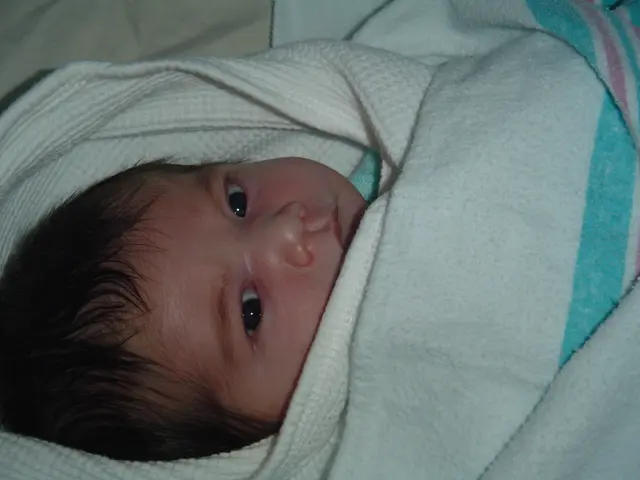Nap-Induced Headache: Uncovering 9 Potential Reasons and Prevention Strategies
You've just woken up from a peaceful snooze, ready to tackle the rest of the day, but a pounding headache ruins your plans. Ugh, headaches after a nap can be a real bummer, leaving you scratching your head (pun intended) wondering what went wrong. In this blog, we'll dive into the mysterious world of post-nap headaches, exploring their possible causes and why sometimes your body just isn't down for a midday siesta.
Types of Headaches
First things first, let's try to figure out the type of headache you're dealing with. As always, if you're unsure, it's best to consult a healthcare professional.
Primary Headache
A primary headache is a distinct condition that's not caused by other illnesses. Migraines, cluster headaches, and tension headaches could be the culprits here. Neck muscle discomfort, overactive nerves, brain chemicals, or dilated blood vessels are just some factors that could be at play. Plus, primary headaches can run in families.
Secondary Headache
Secondary headaches occur when pain-sensitive nerves in the head are activated due to an underlying medical condition, such as the flu, ear infections, sinus infections, or other ailments. Identifying and addressing the root cause of these secondary headaches is crucial for effective management and relief.
What Causes a Headache After a Nap?
Headaches after a nap are generally nothing to worry about, but they can be explained by various reasons, including dehydration, poor sleeping posture, allergies, sleep duration issues, and even more complex conditions like sleep apnea or teeth grinding (bruxism). While many post-nap headaches are harmless and can be linked to common factors like these, persistent headaches should be investigated by a healthcare professional.
Below are the 9 most common causes of headaches after a nap:
1. Dehydration
The most common cause of experiencing a headache after a nap is dehydration. To prevent this, it's crucial to stay hydrated by sipping on water throughout the day. Skipping meals, such as lunch, or being constantly on the go without breaks can contribute to dehydration, which may lead to various health problems, including headaches. Signs of dehydration include dry mouth and lips, dark-colored urine, lightheadedness, and changes in mood.
2. Bruxism (Teeth Grinding)
Persistent headaches can be the result of unconsciously clenching your jaw during sleep, as it puts extra tension on your head's muscles. This can also make even yawning painful. Besides causing headaches, chronic teeth grinding (bruxism) can also lead to dental issues and jaw discomfort.
3. Too Much Coffee
A delicious cup of coffee provides an instant energy boost. But drinking too much coffee and caffeinated drinks can lead to unpleasant side effects like headaches after a nap. Migraines may develop due to excessive caffeine intake and dehydration. So remember to balance your coffee consumption with plenty of water to keep your body nicely hydrated.
4. Tension In Muscles
A muscle strain could be the cause of a headache that worsens after a nap. Tension headaches occur when neck, shoulder, or jaw muscles become painful and transmit discomfort to the head. These headaches can be caused by long periods of continuous driving, extended desk work, or repetitive strain injuries. Relaxation techniques like deep breathing exercises or gentle neck and shoulder stretches can help alleviate muscle strain-related discomfort.
5. Hunger
Lack of food causes a drop in blood sugar levels, leading to headaches around lunchtime if you skip breakfast. Taking a nap on an empty stomach can also result in waking up with a headache. Skipping lunch can exacerbate this issue, causing even more pronounced midday headaches. If you feel hungry, try a small banana and a glass of water before bed.
6. Allergies
Allergens can be a significant factor in post-nap headaches. Your frequent sneezing, sore or irritated eyes, fatigue, and overall feeling of illness might be due to allergies. Consult a healthcare professional if you suspect allergies, as they may recommend antihistamines to address your symptoms.
7. High Blood Pressure
If your high blood pressure readings are 180/120 mm Hg, and you also experience a headache after a nap, it's vital to consult a doctor immediately. High blood pressure often doesn't cause headaches. If your blood pressure isn't extremely high, it usually won't result in a headache. If you have high blood pressure, feel lightheaded, or show signs of skin rashes, seek immediate medical assistance.
8. Sleep Apnea
The connection between sleep apnea and headaches after a nap can be attributed to the disruption of sleep patterns caused by sleep apnea. People with sleep apnea or untreated sleep apnea may be more likely to experience headaches after daytime naps due to compromised sleep quality. Addressing sleep apnea through proper treatment can greatly improve sleep quality and alleviate daytime symptoms like headaches. If you or someone you know is struggling with sleep apnea or related symptoms, it's essential to seek guidance from a healthcare professional for proper assessment and management.
9. Wrong Pillow
Can pillows cause headaches? Actually, using the wrong pillow can be a surprising underlying cause behind post-nap headaches. Pillows that don't provide proper neck and head support may lead to improper spine alignment, causing muscle tension, discomfort, and restriction of blood flow to the brain, potentially triggering headaches. So choosing the right pillow that suits your sleeping position and offers the necessary support is crucial for ensuring a headache-free nap and overall restful sleep.
How to Avoid a Headache After a Nap
Living in today's fast-paced world often means skipping meals and being busy with errands. However, this hectic lifestyle can sometimes bring unexpected headaches after a quick nap. This section will cover some practical strategies to help you avoid that frustrating head pain when your schedule doesn't allow for a leisurely midday rest:
1. Adjust Your Sleeping Position
Instead of napping face down on a table, sleep on your side or your back to avoid discomfort when you wake up.
2. Nap in a Comfortable Place
Rather than reclining on a desk, try taking your naps somewhere where you can lie down comfortably with a quality pillow to provide neck and upper back support, ensuring a quality sleep.
3. Learn to Manage Stress
If you're feeling anxious throughout the day, napping can be challenging. To help your body relax and nap effectively, consider practicing relaxation techniques, such as yoga, meditation, or light exercise before bed.
4. Don't Eat Too Much Before a Nap
Most people use brief naps as stress relief, which is often accompanied by stress eating. To relax your body and avoid feeling overly bloated when you wake up, try to avoid eating a large meal right before bed.
5. Exercise Caution When Using Caffeine
If you drink coffee before your nap, take a short siesta immediately afterward, as the effects of caffeine typically start within 30 minutes of consumption. By taking a 10-20 minute nap, you'll enhance your overall sense of refreshment upon waking.
6. Stay Hydrated
Remember to drink plenty of water to prevent dehydration, which is a common issue. Before sleeping, drink a glass of water to maintain proper hydration levels.
7. Set an Alarm and Stick to It
Set your alarm and air on the side of caution by not hitting the snooze button, which would prolong your nap and invite yet another headache. When your alarm goes off, get up and make the most of your day!
8. Use a Sleep Tracking App
Consider using a sleep tracking app like ShutEye®, which offers a smart alarm feature that can gently wake you up during a light sleep cycle. Utilize soothing sounds to help you fall asleep and relax during a short nap.
9. Do Not Ignore Sleep Disorder Symptoms
If you notice symptoms that may indicate potential sleep disorders, do not ignore them! Take proactive steps, including seeking help from a healthcare professional, to address any underlying sleep disorders. These sleep disorders, besides causing headaches after naps, significantly impact overall sleep patterns. Thus, addressing and managing them is essential for enjoying better sleep quality and minimizing persistent headaches.
Conclusion
In conclusion, headaches after naps can be minimized through simple adjustments, such as prioritizing hydration, taking shorter and well-timed naps to reduce sleep inertia, seeking medical attention if necessary, practicing relaxation techniques, and maintaining consistent sleep hygiene with good sleep habits to ensure better sleep quality and fewer headaches. By adopting these strategies, you can reap the benefits of napping without the inconvenience of headaches, improving your overall well-being.
In the journey of understanding post-nap headaches, it's essential to distinguish between primary and secondary headaches. Primary headaches, such as migraines, cluster headaches, and tension headaches, may be caused by various factors like neck muscle discomfort, overactive nerves, brain chemicals, or dilated blood vessels. Secondary headaches arise due to underlying medical conditions, like flu, ear infections, sinus infections, or sleep apnea, which can cause teeth grinding (bruxism).
Some common causes of headaches after a nap include dehydration, bruxism (teeth grinding), too much coffee, tension in muscles, hunger, allergies, high blood pressure, sleep apnea, and the wrong pillow. Encountering persistent headaches suggests seeking professional advice for adequate diagnosis and treatment.
To prevent post-nap headaches, focus on maintaining good sleep hygiene, stay hydrated, manage stress, avoid eating too much before a nap, exercise caution with caffeine, improve your sleeping posture, learn relaxation techniques, nap in a comfortable place, and do not ignore sleep disorder symptoms. Utilizing sleep-tracking apps, like ShutEye®, can help monitor your sleep patterns and ensure a restorative nap. By following these strategies, you can enjoy rejuvenating naps without the annoyance of headaches, thus promoting your health and mental well-being.








